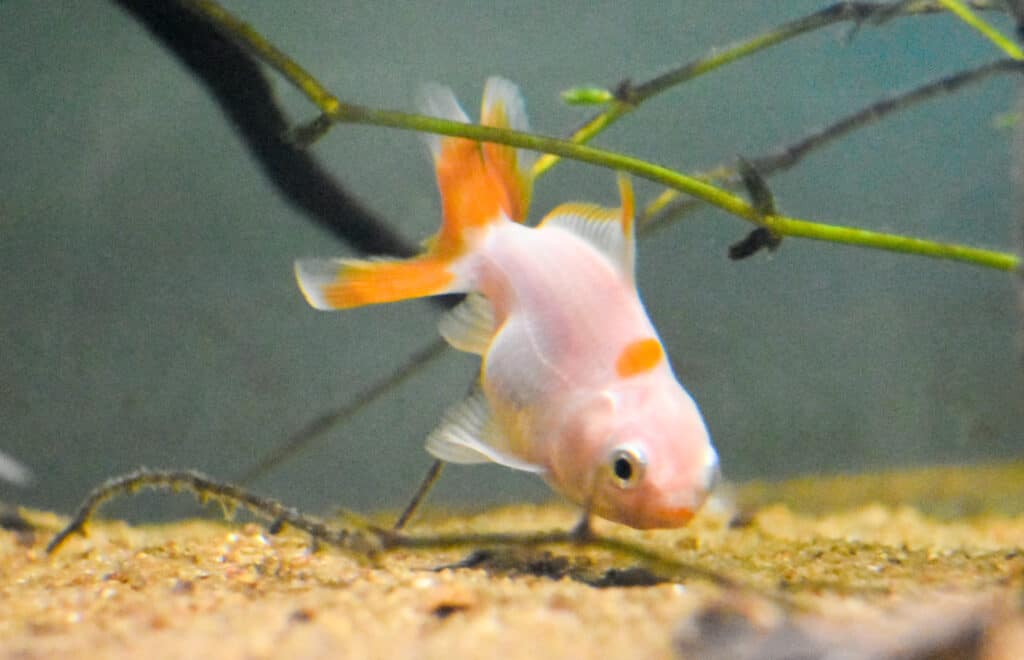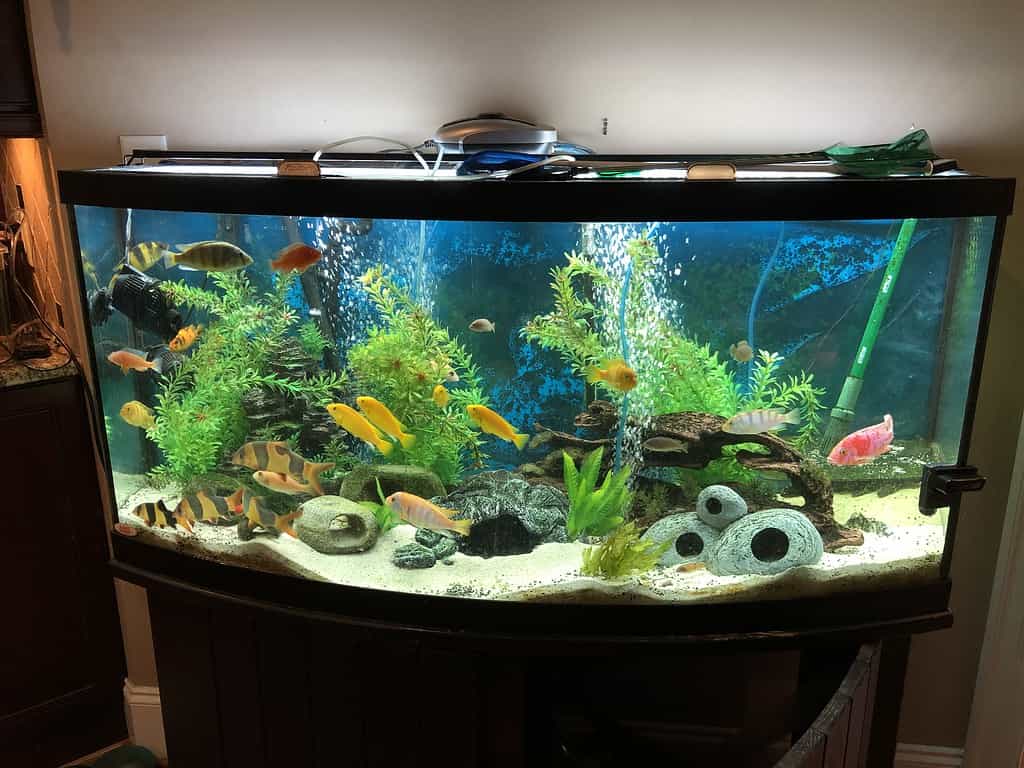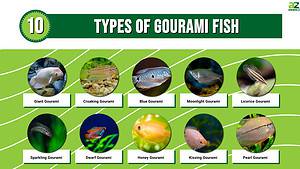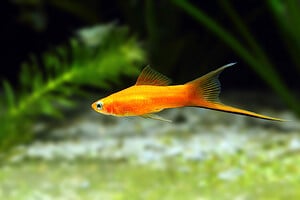Whether you are an experienced fish owner or new to the hobby, there is a lot to know about how to keep your aquatic friends happy and healthy. Proper care of fish goes beyond temperature, choosing the best food, and learning that fish can peacefully coexist in the tank. Owners also need to know how to clean their tanks properly. What is the best way to control algae? Which cleaners are safe for the fish? How do you properly clean your fish tank decorations?
While this might seem overwhelming, don’t be discouraged. With a few basic tips, you’ll be able to clean your fish tank with confidence.

Select which fish tank suits your needs before you begin.
©Veronika Oliinyk/iStock via Getty Images
Setting Up Your Tank
Many first-time fish owners are surprised to find that it is recommended that they set up their fish tank and allow it to run for at least two days before adding any fish. While it might be hard to wait when you’re ready to enjoy your fish, the wait is worth it. This is called allowing your tank to cycle. Cycling your tank at set-up and with every cleaning ensures the water is safe for your fish by removing chlorine and other contaminants.
Choosing Your Tank and Location
Select your tank location first. Even small fish tanks can be extremely heavy once filled with water and decorations. Do not risk injury to yourself or the tank by attempting to move it once full.
You should select the largest tank your budget allows for the type of fish you want to keep. Each fish will need plenty of space to be healthy. This can be tricky when fish come in all sizes, so a general rule of thumb is a one-inch fish for every two gallons of water. For example, a ten-gallon fish tank can reasonably house five small fish, two medium fish, or one large fish.
If you purchase a new fish tank, clean the inside with a cloth and plain water to remove dust and manufacturing debris. If you are setting up a tank that has been used previously, check below for cleaning tips. Never use a sharp instrument or harsh cleaners, as they can damage the silicone coating on your tank.

This goldfish’s tank is equipped with sand substrate, making it suitable for live plants.
©iStock.com/Sudhakar Bisen
Substrate
It’s also a good idea to choose what substrate you want to use in your tank before you set it up. Gravel is a popular choice and is available in many decorative finishes. Be careful, however, that the gravel isn’t a potential hazard for the fish you’ve selected.
Some aquarium owners prefer to grow live plants and choose sand or dirt. Whichever you choose, be sure to add it to your tank before you add water. Once you have your substrate, install your plants and decorations.
Fill your fish tank with water. Whether you use tap water or bottled, be sure to treat the water for chlorine. Water may be high in chlorine, which can harm fish. Chlorine conditioners can be purchased from major pet stores, and many kits come with conditioners included.
If you have a saltwater tank, commercially prepared marine salt should be added to the water until a specific gravity reading of approximately 1.020 is achieved.
Install filtration into the tank. Most aquarium kits have a water filter and an aerator. Protect your fish by installing the filtration system in an area that reduces the chance of fish being sucked into the intake. An aerator is necessary not only for reducing algae growth but also ensuring your fish have enough oxygen.
Finally, test your water’s pH level. PH test strips are also available to major pet-supply retailers. Freshwater tanks require a pH between 6.8 to 7.8, while saltwater tanks require a pH between 8 and 8.4.
Allow the tank to cycle. If you add any organic decorations such as coral, rock, or wood, you will need to re-test your pH level 24 hours after their addition as organic materials can alter the tank pH balance.
Cleaning Your Tank
There is no need to empty the entire fish tank each time you clean it, and it’s not recommended that you do. As fish live, they create a bacterial balance in the aquarium that is necessary for their health. If you empty the tank each time you clean it, you stop this process. This is also known as the nitrogen cycle. It essentially helps keep ammonia in the water at a level that’s not harmful to your fish. It is best to remove only a quarter of the water for each cleaning. Maintaining bacterial balance can also protect your fish from Red Pest Disease.
You should prep your replacement water in a bucket before cleaning. This allows time to dechlorinate, mix your salt ratio for a saltwater tank, and test the pH before adding it. Avoid adding water then salt directly to the tank for your saltwater aquarium, as this can create pockets of high salinity that can harm your fish.

An aquarium vacuum, also called a siphon, is necessary to keep your tank clean.
©Ladanifer/iStock via Getty Images
Substrate Cleaning is an Important Step
Substrate cleaning is the first step in cleaning the tank. Leftover food and fish waste sink to the bottom of the tank, where they can decay and breed bacteria. This can not only contribute to algae growth, it can harm your fish.
Whether you use gravel or sand, carefully vacuum the substrate with an aquarium vacuum.
If sand is used as the substrate, stir the sand following the vacuum. Deep waste pockets in the sand can fester and create anaerobic pockets that can release hydrogen sulfide gas into the tank. Hydrogen sulfide gas is toxic to fish.
Keeping Your Fish Tank’s Glass Clean
Investing in a tank glass cleaner is highly recommended. These are small, dual-sided tools that are affixed to the glass of the tank. One side of the tool is a magnet, while another is a sponge. You simply guide the magnet, which is on the air side of the tank, to move the sponge side across the glass, removing any algae or residue.
If you have build-up on your tank or want a deeper clean, you should invest in an aquarium scraper. This tool has a long handle and a scaping end.

Decorations beautify your tank and provide hiding spots for your fish, but require cleaning, too.
©LizWinfreyV, CC BY-SA 4.0, via Wikimedia Commons – License
Decorations
You should clean your decorations if you notice that they are developing a build-up of algae or biofilms. Never use soap on your decorations or the inside of your tank. Even if they appear well-rinsed, soap can leave a harmful residue that can disrupt the fish tank’s bacteria and harm the fish. Instead, soak your decorations in hot water and use a bristled brush to clean all surfaces.
If you have live plants, use small scissors to trim them. Trimmings should always be removed, as they can decay in the aquarium.
Check and Change Your Filter
While you won’t have to change your filter each time you clean your tank, you should always check to ensure it’s properly seated and not blocked. Check the line and clear out any debris that may have been taken in with the water with a filter cleaner.
Adding Water Back to the Fish Tank
Once you’ve done all of the above, it’s time to add water back into your tank. Slowly add the water to not disturb your fish. Once you’ve added all of the water, check the pH of your tank. It’s a good idea to double-check the pH again after your tank has completed a cycle, or after twenty-four to forty-eight hours.
How to Remove Calcium Safely
Have you noticed a hard, white cloud building up on the glass of your tank? This is most likely calcium deposits, and they can occur through the natural evaporation of the water in your tank. If you have these, you may be able to remove them with a scraper. If your deposits require more intensive cleaning, you can remove half of the water from your tank and treat them with a clean cloth and vinegar to soften, then scrape.
Proper care of your aquarium will not only help to keep your fish healthy, it will extend the life of your tank. With just a little care of pH levels and to avoid potentially harmful chemicals, you’ll be ready to enjoy your aquarium.
The photo featured at the top of this post is © Grafner/iStock via Getty Images
Thank you for reading! Have some feedback for us? Contact the AZ Animals editorial team.






